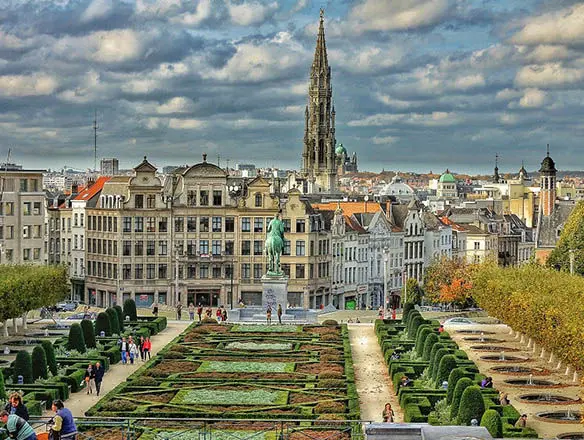
Audio 1 - Let the visit begin!
Have you chosen Brussels as your next destination? It’s an excellent choice! Both beautiful and dynamic, the Belgian capital is sure to seduce you. It knows how to use all its assets: culture, architecture, entertainment, gastronomy ... We can also count on its inhabitants' good humour and the typical atmosphere we find around its streets! More than any other city, Brussels has the secret to best satisfy its visitors. You will certainly be amazed by the beauty of the Grand-Place and its lights. Don’t hesitate to stroll around the Marolles market while discovering the poetic and pictorial universe of Magritte. But don't miss out on good mussels and fries accompanied by a local beer. And then, fall back into childhood by following in the footsteps of your favourite comic book heroes!
Make your stay in Brussels an unforgettable experience: this audio guide (audio guides) will accompany you step by step through this essential city, so you do not miss any of its treasures.
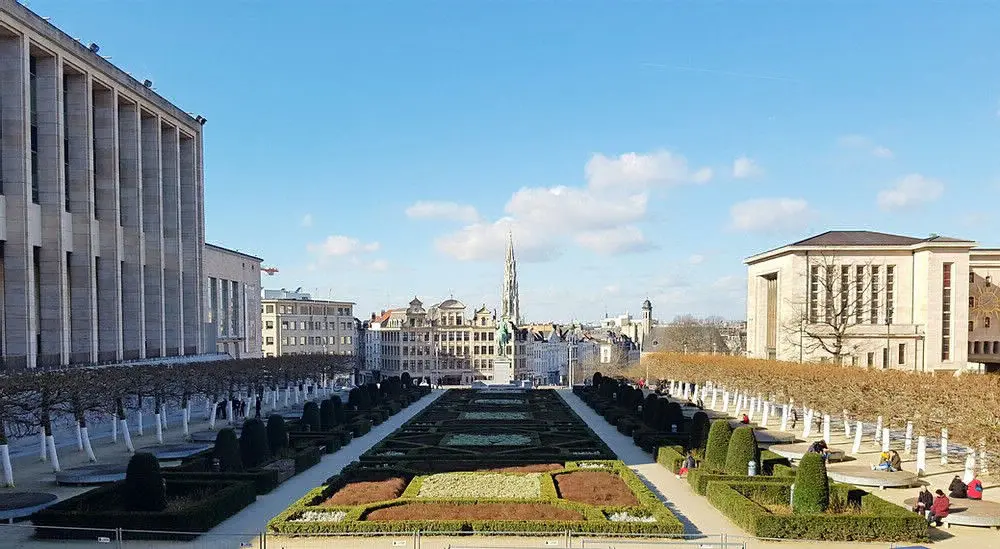
Audio 2 – THE GRAND-PLACE
The Grand-Place is Brussels’ nerve center. During your visit, you will cross it more than once with the audio guide (audio guides)! Listed as a UNESCO World Heritage Site, it's considered one of the most beautiful squares in the world for its great ornamental and aesthetic richness.
Its origin dates back to the 15th century, with the construction of guild houses, where wealthy merchants once lived. The town hall was then built there, to establish authority in this place conducive to trade. On two occasions the square was sacked by the French, the first time in 1695 during the Augsburg League War and the second time during the French Revolution of 1789. The buildings have since been reconstructed. The current facades are, for their part, the result of a major restoration campaign in the 19th century. Four architectural styles are mixed and juxtaposed: Gothic, Baroque, Neoclassical and Neo-Gothic. There is very little information available concerning the architects and project managers who made the square’s various buildings.
If you look up at the town hall spire, you will see the statue of Saint Michael slaying the dragon, the town’s patron saint which stands almost 96 meters high. The peculiarity of this Gothic building lies in its asymmetry. Indeed, its spire is off-center and the right part of the building differs from the left part. The people of Brussels joke that the architect committed suicide when he realized his mistake.
Facing the town hall, the King's House is one of the most remarkable buildings. It now houses the city museum. In the 12th century, there was only a modest wooden establishment where bread was sold. The building was replaced in the 15th century by a stone building that housed the Duke of Brabant's administrative services, it then bore the name of "Duke's House". When the duchy came under Spanish domination, it was then renamed “King's House”. Heavily damaged, especially during the bombardment of 1695, it was rebuilt in 1873 in a neo-Gothic style.
You can have fun trying to decipher the many Latin verses adorning the square’s facades. But above all, we recommend you make sure you see the square by day, but also at night, to take advantage of the lighted facades that offer a magical spectacle!
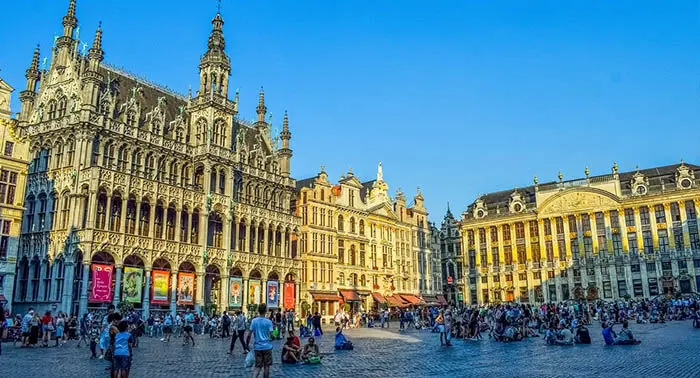
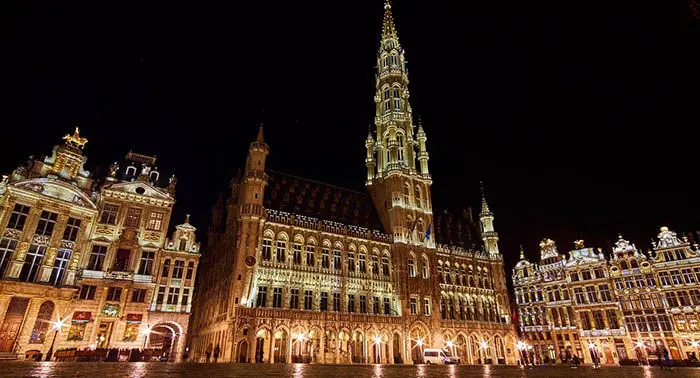
Audio 3 - THE MANNEKEN-PIS AND JEANNEKE-PIS
The very popular Manneken-Pis is big in reputation, but small in size. It only measures a little over 50 cm! However, one cannot have visited Brussels without having seen it because it's the very emblem of the city. This statuette represents a naked little boy peeing in a fountain.
In the 14th century, there was already a stone fountain here with a similar statue, but it was stolen. In 1619, the Baroque sculptor Jérôme Duquesnoy was commissioned to make a bronze statuette to replace the previous one.
Since then, the Manneken-Pis has been standing at the corner of its street for 400 years and various legends have been attributed to it. One of them tells of a child allegedly extinguishing the fuse of an explosive charge placed by foreign enemies by urinating on it. He would thus have prevented the city from burning. It's also said that during a battle, the count of Brussels Godfrey III of Leuven would have hung the cradle where his young son slept on a tree and the latter would have urinated on the enemy troops. It could also have been a child who got lost in the city’s streets and was found urinating on a street corner.
The Manneken-Pis has another particularity that it only wears on certain occasions: its costumes. In 1698, a governor gave a tunic to the statuette as a gift, a gesture that is at the origin of a long tradition that continues today. Since then, nearly 700 costumes of all styles and origins have been donated by various representatives of countries, institutions and associations, during official visits. The city museum, located in the King's House, allows you to discover the collection of costumes that make up the little hero's wardrobe. With the audio guide (audio guides), you can see hundreds of miniature regional costumes, some of which are quite unexpected, like that of a bullfighter or that of Elvis. The Friends of the Manneken-Pis association is responsible for dressing the statue for special occasions.
Since 1987, the Manneken-Pis has had its female counterpart, the Jeanneke-Pis.
Located at Fidelity Impasse, it's the work of sculptor Denis-Adrien Debouvrie. Carved from blue limestone, it's also around 50cm tall and depicts a mischievous-looking girl with two pigtails, crouching down peeing. Another great example of the legendary Belgian sense of humour!
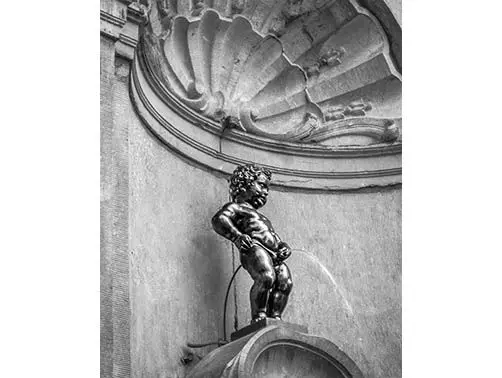

Audio 4 – THE SAINT-HUBERT ROYAL GALLERIES
Next stop of our audio guide (audio guides), the Saint-Hubert Royal Galleries are the oldest covered shopping arcades in Europe. Designed in 1836 by architect Jean-Pierre Cluysenaer in a neo-Renaissance style, it was not until 1845 that the project obtained the necessary funding to start work. This necessitated the expulsion of many modest families, who lived in these dark and austere streets. The galleries were finally inaugurated in 1847 by the first king of the Belgians, Leopold I.
The concept was very innovative for the time, as galleries brought together shops, restaurants, cafés and bookstores in one place. Both luxurious and elegant, they are approximately 200 meters long. The huge glass dome lets in light and protects from the rain, making it easy to walk around whatever the weather.
They are divided into 3 parts: the Queen’s Gallery, the King's Gallery and the Prince’s Gallery. The upper floors, meanwhile, contain private apartments.
The Galleries make the link between the historic heart of Brussels and the most modern part by connecting the Monnaie Theatre district to the Grand-Place. It's accessed from Herb Market Street or Butcher Street, or from Squire Street.
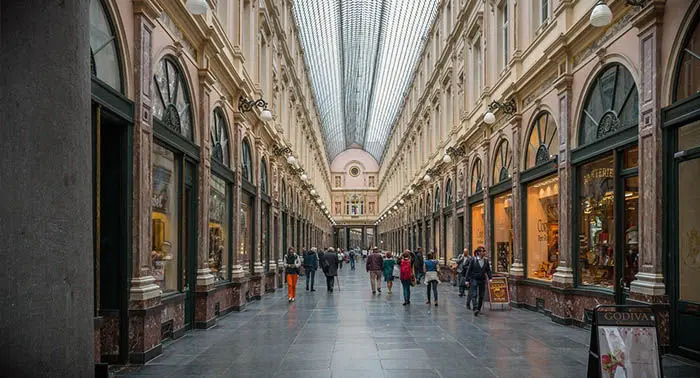
Audio 5 - BELGIAN CHOCOLATE
Belgium has a wide variety of chocolate brands and some of the most famous factories. Belgian chocolate’s reputation was forged thanks to the quality of the cocoa beans used and the particular care taken throughout the production process.
Belgian chocolatiers are particularly creative: nowhere else will you find such a wide variety of flavours and combinations, from classic pralines to taste innovations, including the most exotic flavours, always with the same desire to surprise by their originality.
Treat yourself to an unforgettable taste experience. Not just by buying chocolate, but by taking advantage of the wide range of activities related to the world of chocolate making, from chocolate museums and the making of chocolates to tastings associated with beer. We recommend that you visit in particular the Brussels Choco-Story museum, where you will discover the history of chocolate and cocoa culture and will attend a demonstration by a master chocolatier with tasting included!
The following points of our audio guide (audio guides) mention other culinary specialties of Belgium: dedicated to all gourmets!

Audio 6 – WAFFLES
Like chocolate, beer or fries, waffles are part of the Belgian gastronomic heritage. Smelling the sweet scent of waffles around every corner, it will be hard to resist the temptation to savour one during your visit.
In Brussels, there are two types of waffles: the Brussels waffle itself, perfectly rectangular; it's light and crisp on the outside. As it's naturally not very sweet, it's generally accompanied by icing sugar or chocolate. It made its appearance at the end of the 19th century but has become very popular with the 1958 Brussels Universal Exhibition.
The other type is the Liège waffle. It's more oval, softer in texture and its flavour sweeter. The crunchy touch is provided by the sugar pearls incorporated into the dough at the end of preparation. Slightly caramelized on the edges, Belgians eat it without anything, but you can also add chocolate, fruit or ice cream.
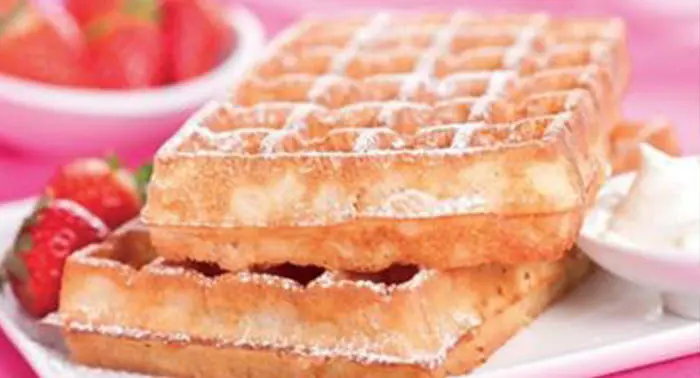

Audio 7 – "MUSSELS-FRIES"
If there is a typical dish in Brussels, it's their famous mussels and fries. It's estimated around 60,000 tonnes of mussels are consumed each year in Belgium! They are usually served in the same dish in which they were prepared. A little salt, pepper, parsley and celery, and it's ready!
In Belgium, we often use the shell of the first mussel we eat like tongs to be able to catch the following ones more easily.
If there's one place where fries are king, it's in Brussels. To make them very crispy on the outside, they are fried twice. Only one variety of potato is used, called the bintje. It's considered the tastiest in the world. It's believed that it's since the end of the 19th century that French fries stalls started serving mussels on the side and the consumption of mussels and fries then became popular. It was not until much later that this dish was found on restaurant menus.
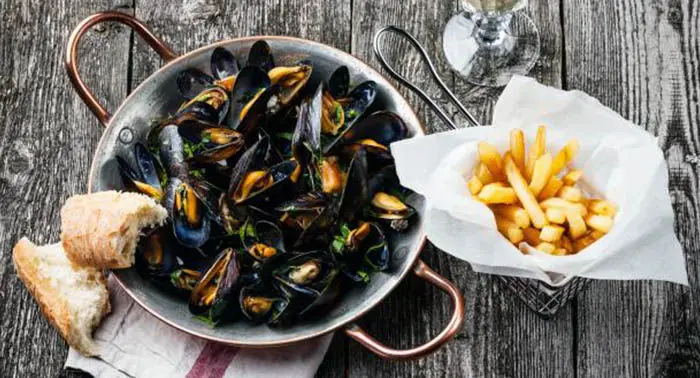
Audio 8 – BELGIAN BEERS
Beer is so important in Brussels that we could devote an entire audio guide (audio guides) to it! There are nearly 180 breweries in Belgium, both major international brands and small craft breweries. At the end of 2011, there were around 1,150 Belgian beers: isn't that a good reason to embark on their discovery?
You will surely wonder why Belgian beer is so famous. Did you know that in the 12th-century beer was already produced in Belgium, and the first Craftsmen Brewers Corporations made their appearance in the 14th century?
The secret to understanding the difference between beers is the ingredients and the fermentation. Most beers use barley as the main ingredient, although malt or wheat are also frequently present. Belgium has chosen another path, more experimental, where fruits, herbs and even sugars are the protagonists. Another big difference is the type of fermentation, which makes it possible to create unrivalled varieties of beer.
Among the low fermentation beers, Pilsners have a light colour and a light taste; they are the most commonly sold and they represent 75% of the production of Belgian beers. The most famous brands are Stella Artois, Jupiler y Maes.
The so-called high fermentation beers include, among other things, the typical abbey beers and Trappist beers. They are made according to the traditional recipes of ancient monasteries. Brown or blond, they have between 6º and 8º. Some of the best-known brands are Leffe, Grimbegen, or Chimay.
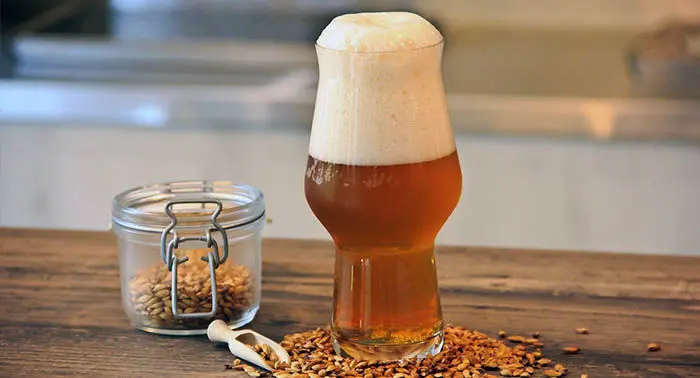
Audio 9 – BELGIAN BEERS: PART TWO
The selection of Belgian beers in our audio guide (audio guides) doesn’t stop there: in Brussels, you will also find so-called spontaneous fermentation beers. This means it does not require the addition of yeast in the mash; exposed to the open air, it's seeded with wild yeasts. It was the method of beer production before the cultivation of yeast, mastered during the Middle Ages. Today it's used more often in Belgian lambic-type beers and gives an acid taste.
Lambics are the only beers that experience spontaneous long-term fermentation: from 3 to 6 months, they are considered “young”, and from 2 to 3 years, “ripe”. Lambic can be drunk directly after making it, but it's primarily used as a base for preparing gueuzes, faros and fruity beers.
The Gueuze is a clever mix of young and older lambics. It's then refermented in the bottle without adding yeast for about 6 months. The most famous brands are "Mort Subite", "Belle Vue", "Cantillon" and "Saint Louis".
Fruity beers are made by adding fruit or fruit juice to lambic. The most famous variety is the Kriek, with a nice cherry flavour. Other beers use raspberries, peaches, blueberries or even apricots.
To make the Faro, sugar or caramel is added to the lambic to cause a second fermentation. With a sweeter taste, this beer goes easily with many desserts and is excellent for thirst.
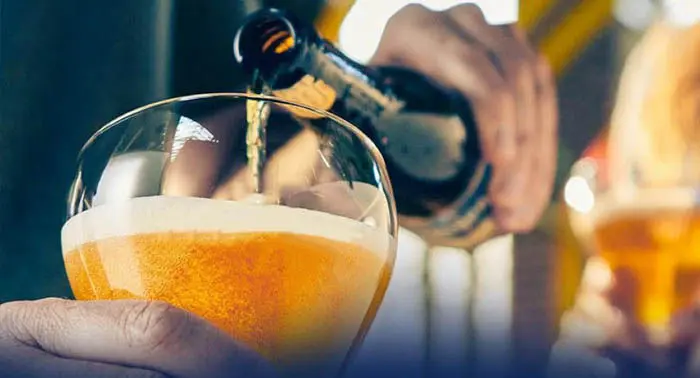
Audio 10 - COMICS MUSEUM
Brussels is considered the world capital of comics. It has seen the birth of many great authors of the ninth art. Our audio guide quotes Hergé, the author of the Adventures of Tintin, but also Peyo and his Smurfs, or even Franquin, to whom we owe Gaston Lagaffe and the Marsupilami.
It's to honour these legends that the Comic Strip Museum was created. It's located in a magnificent Art Nouveau building designed by the architect Victor Horta, and it's a visit that no big comics fan will be able to resist. As soon as you pass the door, you are already transported to another world, where Hergé's lunar rocket, the bust of Tintin and the 2 Horses of Boule et Bill (known in English as Billy & Buddy) mingle. The museum is divided into several parts. There is in particular the section which tells the story of the comic strip’s invention but also a room which explains step by step all the stages of the process of creating a comic strip. Many original prints are on display and some spaces are entirely dedicated to Belgian comic book heroes such as The Smurfs, Tintin or even Johan and Peewit.
But comics even invite themselves beyond the walls of the museum. We find them, in fact, through about fifty murals on certain facades of the capital. While strolling with the audio guide (audio guides), you will be able to come across the shadow of Lucky Luke, the Gauls Asterix and Obelix, Tintin, Billy and Buddy, Gaston Lagaffe… and many others! The comic strip trail is an original and fun way to discover Brussels differently.
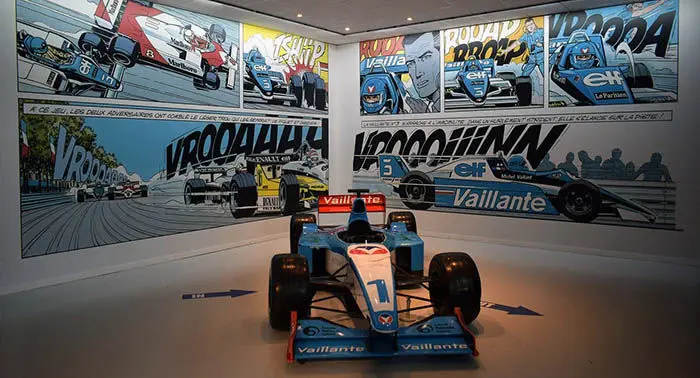
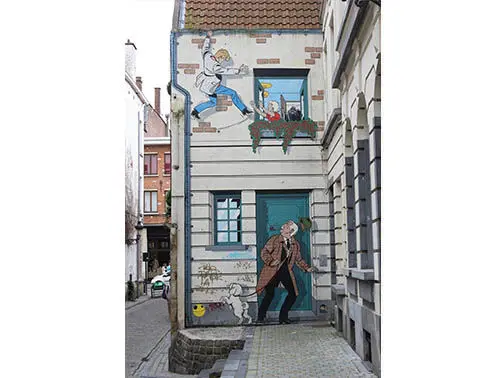
Audio 11 – THE MAGRITTE MUSEUM
In Brussels, four museums are grouped under the name of Royal Museums of Fine Arts of Belgium: the Old Masters Museum, the Modern Museum, the End of the Century Museum and the Magritte Museum. In total, they bring together a prestigious collection of nearly 20,000 works of art. Suffice to say it's impossible to see everything in one day!
If you like surrealism and you only have time to visit one of these museums, then our audio guide (audio guides) highly recommends the Magritte Museum. The surrealist artist lived in Brussels for 25 years and was where he painted half of his works. The museum presents the richest collection in the world dedicated to the Belgian painter, with over 200 works among which are paintings, drawings, sculptures and advertising posters. On the museum’s three floors, you will immerse yourself in the artist’s strange and mysterious universe, in the middle of silhouettes of men in bowler hats, birds with bodies made of clouds and sky, not to mention the famous everyday life objects like apples, pipes and umbrellas.
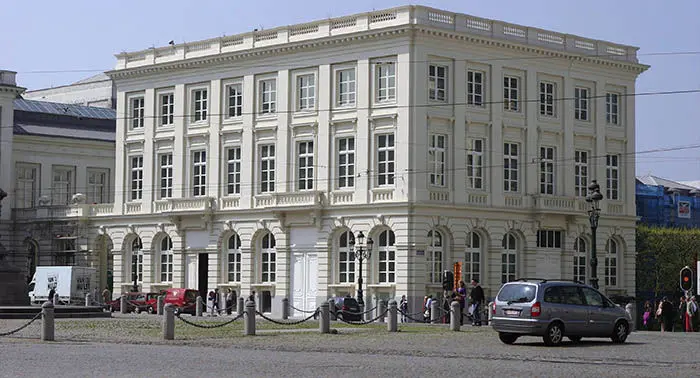
Audio 12 – THE ATOMIUM
Spending a few days in Brussels is the perfect opportunity to go for a walk around the famous Atomium. 102 meters high, it was built for the 1958 Universal Exhibition.
The Atomium is the work of engineer André Waterkeyn. It was built by the architects André and Jean Polak. Its nine steel spheres represent an iron crystal magnified 165 billion times. Some see the nine spheres as a reference to the nine Belgian provinces that made up the country at that time (but which today number 10). Each sphere measures 18 m in diameter for a weight of 250 tonnes.
This monument, which was to be dismantled after the six months of the exhibition, finally became, like the Manneken-Pis, one of the symbols of Brussels. So much so that it's found on 2 euro coins. So we could not forget to mention it in this audio guide (audio guides)!
From 2004 to 2006, it was renovated to strengthen its structure and allow visitors to access its interior. Six of the nine spheres can now be visited. They are accessed by escalators that pass through the tunnels connecting each sphere. By taking the central elevator you can also go to the panoramic restaurant located in the highest sphere. The other spheres, for their part, house temporary exhibitions. One of them even has a space reserved for children and an exhibition retracing the history of Brussels during the 1950s and the Universal Exhibition.
Before leaving the Atomium, take a short tour of the Mini-Europe park, to visit Europe in passing in a few steps from Big Ben to the Eiffel Tower. It's a unique place from where you can admire the Arc de Triomphe with a breathtaking view of Vesuvius. The Mini-Europe park allows you to admire in a scale model the most beautiful monuments and the most emblematic places of the Old Continent. You can stroll the streets of London, bring down the Berlin Wall or watch a bullfight in Seville. A total of 350 miniature models coexist in this very playful theme park.
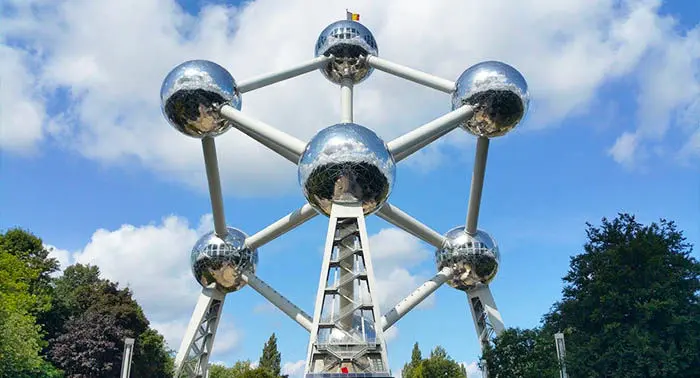
Audio 13 – THE SAINT-MICHAEL-AND-SAINT-GUDULA CATHEDRAL
Construction of Brussels Cathedral began at the beginning of the 13th century on the remains of an old 11th-century Romanesque church. It was the Duke of Brabant Henry I who spurred the work on. These lasted over two centuries. This period coincided with the appearance of the Gothic style in northern Europe. This is why the building presents all the characteristic marks of Brabant Gothic.
The cathedral was known as the Saint-Michael church until 1047, when the remains of Saint Gudula, who died in 712, were placed inside. It was then that the church took the name of Saint-Michael-and-Saint-Gudula. Despite its age, the church only acquired the title of a cathedral in 1961.
Between 1983 and 1989, it was the subject of major restoration work to restore the stones and stained glass to their former splendour. These works also made it possible to find vestiges in very good condition of the first Romanesque church of the 11th century, on which the current cathedral was built.
The interior of the cathedral is quite sparse, due to the many lootings orchestrated in the past by Protestants and French revolutionaries. However, you can admire the right of the central nave a magnificent baroque-style wooden pulpit dating from 1699. Note also the 17th-century oak confessionals and the huge statues at the columns.
The Cathedral Treasury is located in the Chapel of the Blessed Sacrament, jealously guarded by the 18th century wrought iron portico. Inside, a multitude of liturgical and religious objects are preserved, such as tunics, crosses, reliquaries, chalices, various altarpieces as well as sculptures. In the chapel, one can observe with the audio guide (audio guides) several stained glass windows dating from 1540. These are larger than those of the rest of the cathedral.
Don't miss the magnificent Grenzing organ without admiring its 4 keyboards and 4000 pipes!
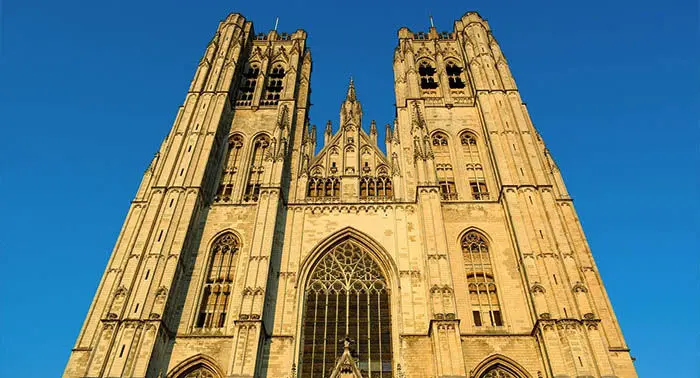
Audio 14 – THE BALL GAME SQUARE AND THE MAROLLES FLEA MARKET
The Ball Game Square is located in the heart of the Marolles district. As its name suggests, the place was intended in the 19th century for the practice of the pelota ball game, a kind of palm game very popular in western Belgium. It was played by hitting the ball with a glove, not a racquet. However, its current Dutch name "Vossenplein" (fox square) refers to the presence of a former locomotive factory which was called the "Fox Company".
A very famous flea market takes place there every morning: the Old Market. More than 400 vendors sell furniture, clothing or decorative items, as well as books, paintings or jewelry. Everything is second-hand and cheap. The whole is arranged in a rather anarchic manner, sometimes on simple blankets on the ground. To find the rare pearl, you’ll need to have a sharp eye!
At the Old Market, we don't just go to the flea market, we travel among a multitude of objects from the past in an atmosphere where time seems to have stopped. Whether you have an antique soul or not, this will be the opportunity to enjoy a calm and pleasant moment and to savour the essence of this typically Brussels place that our audio guide (audio guides) invites you to discover.
Even if your gaze is absorbed by all the sights on the ground, don’t forget from time to time to lift your eyes to gaze at the square itself and its buildings: the Church of the Immaculate Conception bells ring every quarter of an hour. Nearby, the old fire station built in 1859 by architect Joseph Poelaert now houses apartments, shops and art galleries. Its old entrance portico has been converted into a café. Note that under the square, there is a concrete bomb shelter dating from the Second World War!
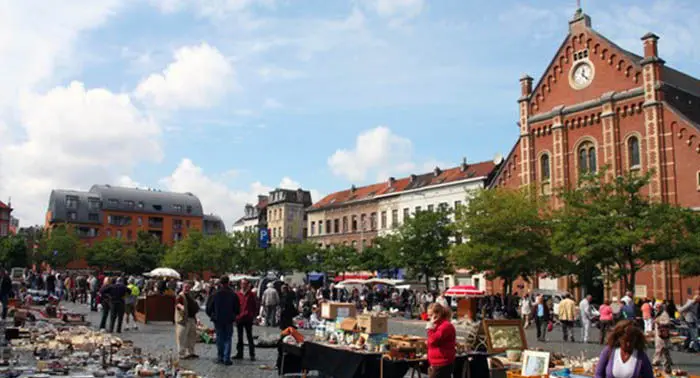
Audio 15 – THE GRAND SABLON
It's hard to believe when walking with the audio guide (audio guides) in this beautiful district, seeing its elegant boutiques and its countless antique galleries, that a vast sandy swamp stood there and that it was afterwards a bad neighbourhood.
The name of this district comes simply from the fact that in the Middle Ages, this place was but a depopulated plain, dotted with swamps and sandy areas. We used to bring wool there to dry it in the open air. More recently and until the 1960s, this neighbourhood had a bad reputation.
Today, Place du Grand Sablon is a refined square, surrounded by houses and hotels whose construction spanned the 16th to the 19th century. There are also typical restaurants and renowned chocolate factories. But the place is best known for its old objects and antiques flea market. It takes place every weekend, and there is something for everyone: 18th-century furniture, fine porcelain, old prints, coins, embroidery and 60s design furniture ... Soak up its authentic and friendly atmosphere. Perhaps you will succumb to the charm of an unusual and unique object which will complete your collection or give a personal touch to your interior.
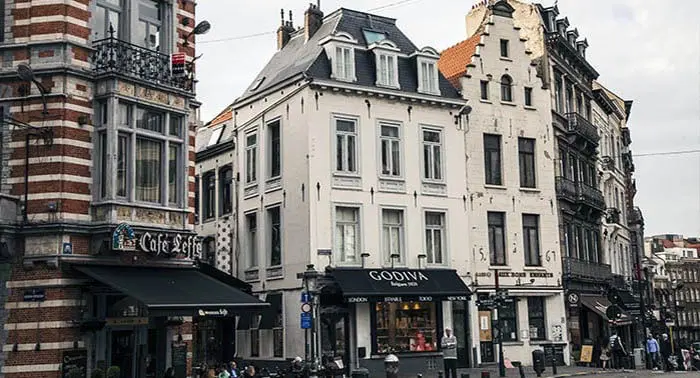
Audio 16 – THE ROYAL PARK
This beautiful green space, formerly called the Royal Park, is known today as the Brussels Park. It was the first public garden in the city. Its wide aisles, symmetrical alignments and surprising perspectives give it great elegance. Designed according to classical architecture principles, it has a rectangular shape whose corners have been truncated. It's the architect Barnabé Guimard, assisted by landscape architect Joachim Zinner who drew up the plans. Its transit areas are made up of 3 main axes crossed by 2 large transverse alleys.
Originally, the Dukes of Brabant Palace gardens were located here. They were redesigned at the same time as the Royal Square and became the central point around which the whole district was reorganized. This is how large-scale work began between 1776 and 1783: trees were felled, the land was levelled and new streets were drawn.
Unfortunately, all this area’s beauty was sacked by the French revolutionaries, who in 1793 destroyed the statues and busts of the Roman emperors which then adorned the park. Soon after, the city got down to work to repair the damage. But the story does not end there: during the Belgian Revolution for Independence, the area served as a refuge for the Dutch army in 1830 and was again devastated.
Victim of the damage of time, the park was the subject of a major restoration campaign which ended in 2001. Equipped with your audio guide (audio guides), you will be able to discover different elements that make it up: a bandstand, two fountains, refreshment stands and a theatre known as "the park theatre". It also has its history: it was built in 1782 and has hosted different types of plays and operettas. During World War I, the building was requisitioned as a recreation area for German troops. Today, it continues to delight audiences with a selection of classic works and contemporary creations.
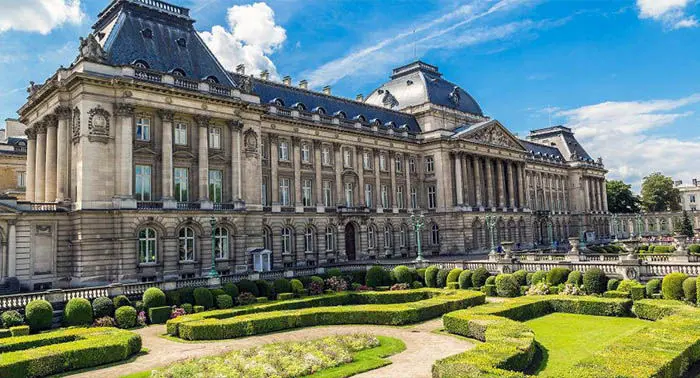
Audio 17 – THE EUROPEAN PARLIAMENT
As you may already know, Brussels is home to the main offices of Members of the European Parliament. If you want to know more, listen to the rest of our audio guide (audio guides)!
The European Parliament is an institution directly representing the Citizens of the European Union. It exercises a legislative function, with the European Commission and the Council of the European Union. The Parliament has two meeting places: on the one hand, the Louise Weiss building located at Strasbourg, where twelve plenary sessions are held four days a year, and which is the official seat of Parliament. On the other hand, the Espace Léopold in Brussels is the second place where parliamentarians meet. It's larger and is used for meetings of Committees, political groups and during additional plenary sessions.
Of the 4 buildings that make up the Espace Léopold, two will surely attract your attention. Both are named after politicians who are considered to be the founding fathers of the European Union. The Paul Henri Spaak Building houses the immense hemicycle made of glass and steel; the Alberto Spinelli building is the main building, and it houses the main permanent institution of Parliament in Brussels, namely the Commission.
Visiting the hemicycle is an excellent way to discover the European Parliament’s role and powers. The 705 deputies meet here for plenary sessions. Free guided tours explain the stages of European integration, the functioning of the European Parliament and the actions of MEPs in the face of today’s various challenges.
The Parlamentarium visitor center offers an interactive exhibition in the 24 official languages of the European Union, making it the ideal place to introduce visitors of all ages to European politics.
Enjoy your visit!
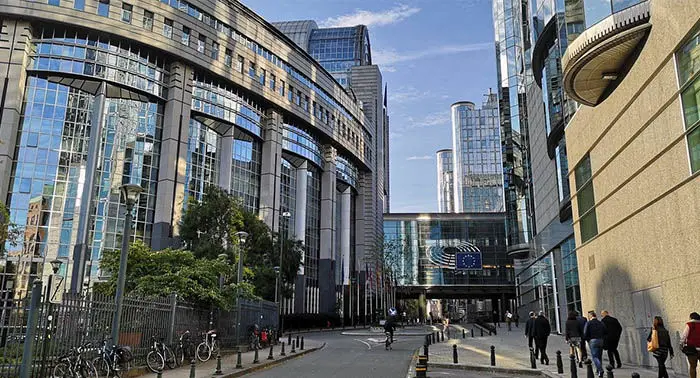
Audio guide devices, Multimedia audio guides,
Audio guide GPS tourist bus-train, charging bases and accessories.
Group guidance systems, headsets, charging cases, tour guide systems accessories.
Audioguides available from mobile devices, web App, downloadable App from Google Store.
Audioguides in several languages, translations, voiceovers. Audio descriptions, signoguides, visual contents for audioguides. 3D Reality.